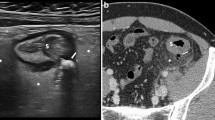Abstract
Purpose There is no consensus about the correct definition of uncomplicated diverticulitis (UD) in clinical practice. We evaluated therefore whether clinical picture of UD differs from complicated diverticulitis (CD). Fifty consecutive eligible patients (21 males, 29 females, mean age 63.6 years, range 47–75 years) were studied. Symptoms, the inflammatory indices, and Computerized Tomography (CT) scan of the abdomen were assessed at the time of admission. Results Thirty-nine patients classified were affected by UD and 11 patients by CD. CD patients showed more severe clinical picture than UD and required urgent Hospital admission. Conversely, most of the patients affected by UD were treated as outpatients. CD patients showed higher symptom scores than UD patients, except the parameter “diarrhea”. All CD patients showed increases in all inflammatory indices. Conversely, all UD patients showed increased ESR, CRP and fibrinogen, but WBC and α1-acid glycoprotein were increased in only a few cases. CT scan in CD patients always showed signs of severe colonic and pericolonic inflammation. Conversely, UD patients often showed moderate localized signs of inflammation without complication. Conclusions Clinical, laboratory, and radiological findings may easily differentiate uncomplicated from complicated diverticulitis of the colon. This integrated approach may be helpful in clinical settings.



Similar content being viewed by others
References
Almy TP, Howell DA (1980) Diverticular disease of the colon. N Engl J Med 302:324–331
Painter NS, Burkitt DP (1971) Diverticular disease of the colon: a deficiency disease of western civilization. Br Med J 2:450–454
Parks TG (1975) Natural history of diverticular disease of the colon. Clin Gastroenterol 4:53–69
Painter NS, Burkitt DP (1975) Diverticular disease of the colon, a 20th century problem. Clin Gastroenterol 4:3–21
Berman LG, Burdick D, Heitzman ER, Prior JT (1968) A critical reappraisal of sigmoid peridiverticulitis. Surg Gyn Obstet 127:481–491
Williams RA, Davis IP (1995) Diverticular disease of the colon. In: Haubrich WS, Schaffner F (eds) Bockus gastroenterology, 5th edn. Saunders, Philadelphia, pp 1637–1656
Results of a Consensus Development Conference (1999) Diagnosis and treatment of diverticular disease. Surg Endosc 3:430–436
Ghorai S, Ulbright TM, Rex DK (2003) Endoscopic findings of diverticular inflammation in colonoscopy patients without clinical acute diverticulitis: prevalence and endoscopic spectrum. Am J Gastroenterol 98:802–806
Tursi A, Brandimarte G, Daffinà R (2002) Long-term treatment with mesalazine and rifaximin versus rifaximin alone for the patients with recurrent attacks of acute diverticulitis of the colon. Digest Liver Dis 34:510–515
Tursi A, Brandimarte G, Giorgetti GM, Elisei W (2006) Mesalazine and/or Lactobacillus casei in preventing recurrence of symptomatic uncomplicated diverticular disease of the colon: a prospective, randomised, open-label study. J Clin Gastroenterol 40:312–316
Narayan R, Floch MH (2002) Microscopic colitis as part of the natural history of diverticular disease (Abstract). Am J Gastroenterol 97(suppl):112
Morini S, Hassan C, Zullo A, De Francesco V, Burattini O, Margiotta M, Panella C, Ierardi E (2005) Epithelial cell proliferation of the colonic mucosa in diverticular disease: a case–control study. Aliment Pharmacol Ther 21:1385–1390
Tursi A, Brandimarte G, Elisei W, Inchingolo CD, Aiello F (2006) Epithelial cell proliferation of the colonic mucosa in different degrees of colonic diverticular disease. J Clin Gastroenterol 40:306–311
Tursi A (2004) Acute diverticulitis of the colon—Current medical therapeutic management. Exp Opin Pharmacother 51:145–149
Tursi A (2005) Mesalazine for diverticular disease of the colon—a new role for an old drug. Exp Opin Pharmacother 6:69–74
Tursi A (2007) New physiopathologic and therapeutic approach to diverticular disease of the colon. Exp Opin Pharmacother 8:299–307
Pereira JM, Sirlin CB, Pinto PS, Jeffrey RB, Stella DL, Casola G (2004) Disproportionate fat stranding: a helpful CT sign in patients with acute abdominal pain. RadioGraphics 24:703–715
Jang H-J, Lim HK, Lee SJ, Lee WJ, Kim EY, Kim SH (2000) Acute diverticulitis of the cecum and ascending colon. The value of thin-section helical CT findings in excluding colonic carcinoma. Am J Roentgenol 174:1397–1402
Author information
Authors and Affiliations
Corresponding author
Rights and permissions
About this article
Cite this article
Tursi, A., Brandimarte, G., Giorgetti, G. et al. The Clinical Picture of Uncomplicated Versus Complicated Diverticulitis of the Colon. Dig Dis Sci 53, 2474–2479 (2008). https://doi.org/10.1007/s10620-007-0161-2
Received:
Accepted:
Published:
Issue Date:
DOI: https://doi.org/10.1007/s10620-007-0161-2



